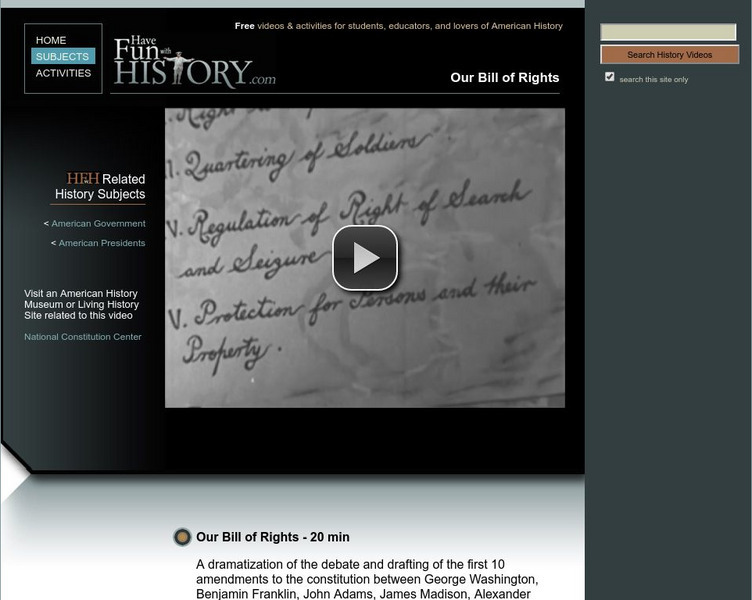Hi, what do you want to do?
Ancient Lights Media
US Constitution: Freedom of Religion
Understanding the U.S. Constitution: 5. This clip explains the guarantee of Freedom of Religion as it is spelled out in the U.S. Constitution.
Mazz Media
Equal Protection Under the Law
EQUAL PROTECTION UNDER THE LAW CHAPTER 1. The Ninth & Tenth Amendment Students will learn that the Ninth Amendment in the Bill of Rights states that the rights of citizens are not limited to those rights spelled out in the constitution....
Wonderscape
History Kids: Constitutional Amendments 6 - 10
This video provides an overview of the Bill of Rights and its importance in protecting the rights of individuals in the United States. It discusses the 6th Amendment, which guarantees the right to a fair trial by an impartial jury, the...
Wonderscape
History Kids: Constitutional Amendments 11 - 15
The video discusses the 11th, 12th, 13th, 14th, and 15th Amendments to the United States Constitution. It explores how these amendments have shaped our country and affected the lives of citizens, particularly focusing on issues such as...
Wonderscape
History Kids: Constitutional Amendments 16 - 20
Explore Constitutional Amendments 16 through 20 and understand why the Bill of Rights was a necessary addition to the Constitution. Detailed explanations of the amendments are presented with landmark cases and an analysis of each...
Curated Video
Ottawa unveils air passenger bill of rights
The federal government released draft rules aimed at forcing airlines to provide better customer service, including possible compensation for passengers who are bumped from flights due to overbooking.
Curated OER
The Bill of Rights
Why was the Bill of Rights necessary after the Founding Fathers spent so much time drafting the Constitution? Watch an informative video that explains what the Bill of Rights is and why it is important.
Curated OER
US Government Review Part 1 - 3 Branches of Government
A fun and interesting teacher describes the three branches of the US government. His lecture style and ability to explain with good examples could be a really big help to older students needing a tutorial or extra support in...
NASA
Nasa: "Nasa at 50" Series: 1998: Work Begins to Preserve Charters of Freedom
A brief video that shows how NASA assisted the National Archives in preserving the original copies of the Charters of Freedom -- the U.S. Constitution, the Declaration of Independence and the Bill of Rights. [6:39] Read the teacher's...
National Constitution Center
National Constitution Center: Constitution Hall Pass: The Bill of Rights
Video that examines the first ten Amendments to the Constitution which make up the Bill of Rights, their history, and their impact on the lives of Americans. [15:00]
Other
The Center on Congress: The Bill of Rights
Explains how the Bill of Rights came into being and some of the rights that are enshrined in it. [1:00]
US National Archives
Nara: Big Picture: To Keep and Bear Arms
Video [29:01] published ca. 1974 on the American rifle and its historical role in keeping America free.
TED Talks
Ted Ed: A 3 Minute Guide to the Bill of Rights
Daily, Americans exercise their rights secured by the Constitution. The most widely discussed and debated part of the Constitution is known as the Bill of Rights. Belinda Stutzman provides a refresher course on exactly what the first ten...
Backstory Radio
Back Story Radio: Wall of Separation: Church & State in America
BackStory Radio episode exploring the separation of church and state and freedom of religion and what that has meant to various groups throughout history. Audio and transcripts are provided.
National Constitution Center
National Constitution Center: Constitution Hall Pass: Freedom of Expression
Video introduced by Judge Sandra Day O'Connor where she talks about the Supreme Court's role in making decisions about freedom of speech. We then learn about why a Constitution was needed, the struggle for ratification, and how the three...
PBS
Pbs Learning Media: Founding Principles: Civil Liberties
Explore how civil liberties are protected under the Bill of Rights. Through a study of foundational documents like the Constitution and key Supreme Court cases like Barron v. Baltimore, New York Times v. The United States, and Roe v....
PBS
Pbs Learning Media: Crash Course Government and Politics: Civil Rights and Liberties
In this episode, we review civil rights and civil liberties. Often these terms are used interchangeably, but they are very different. Our civil liberties, contained in the Bill of Rights, once only protected us from the federal...
Have Fun With History
Have Fun With History: Our Bill of Rights
A dramatization of the debate and drafting of the first 10 amendments to the constitution between George Washington, Benjamin Franklin, John Adams, James Madison, Alexander Hamilton and more.
Center For Civic Education
60 Second Civics: Legal Protections of Rights Pt. 2: How Rights Are Protected
In the United States, there are various ways that the rights of individuals are protected.
Center For Civic Education
60 Second Civics: Legal Protections of Rights Pt. 3: What Gov. Must/must Not Do
The Bill of Rights contains both prohibitions against government actions and positive mandates.
Center For Civic Education
60 Second Civics:rights in British History Pt. 14: Amer. And Eng. Bill of Rights
Today we discuss the differences between the American and English Bills of Rights.
Center For Civic Education
60 Second Civics: Rights in British History Pt. 17: Written Constitution
The Founders learned from experience that a written Constitution and Bill of Rights was required in order to safeguard our liberties.
Center For Civic Education
60 Second Civics: Ratifying Constitution Pt. 4: The Anti Federalists
George Mason, Elbridge Gerry, Richard Henry Lee, Patrick Henry, and Mercy Otis Warren were all notable Anti-Federalists. Their strongest objection to the Constitution was that it lacked a Bill of Rights.
Center For Civic Education
60 Second Civics: Bill of Rights Pt. 11: Personal Rights
Personal rights are one of three common categories of rights and describe the rights of individuals. These rights are based on natural rights philosophy.











